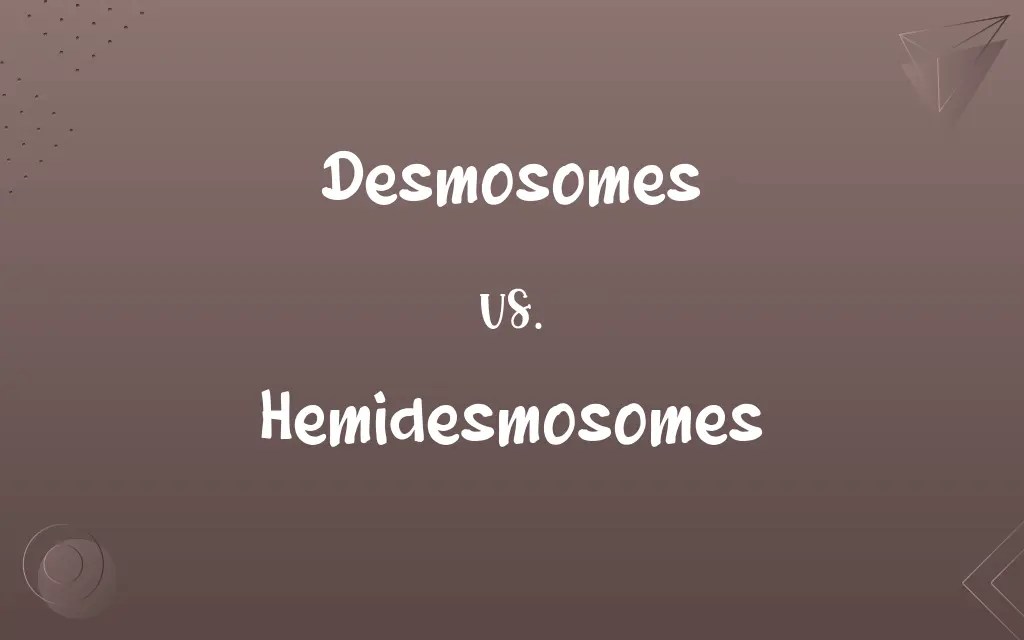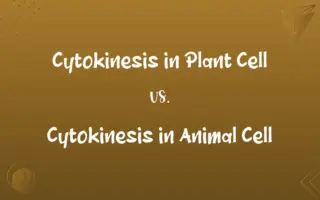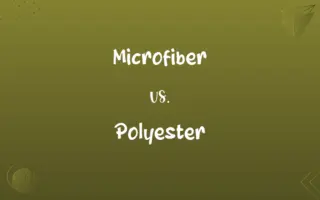Desmosomes vs. Hemidesmosomes: Know the Difference

By Hifza Nasir & Dua Fatima || Published on March 5, 2024
Desmosomes link adjacent cells together, providing tissue strength, while hemidesmosomes anchor cells to the basement membrane, ensuring tissue stability.

Key Differences
Desmosomes and hemidesmosomes are both cell structures that provide mechanical stability to tissues, but they serve different functions and have distinct formations. Desmosomes are junctions between adjacent cells, primarily found in tissues that undergo significant stress, such as skin and heart muscle. Hemidesmosomes, in contrast, are found at the interface between epithelial cells and the underlying basement membrane.They function by linking the intermediate filaments of one cell to those of another, distributing tension and reinforcing the structural integrity of tissues.
Dua Fatima
Mar 05, 2024
Desmosomes function by linking the intermediate filaments of one cell to those of another, distributing tension and reinforcing the structural integrity of tissues. Hemidesmosomes serve as anchoring points that attach epithelial cells to the extracellular matrix, providing stability and ensuring that the epithelial layer remains secure against the basement membrane. This anchorage is crucial for tissue repair and for maintaining the barrier function of epithelia.
Hifza Nasir
Mar 05, 2024
Desmosomes are composed of cadherins (desmoglein and desmocollin) that interact in the space between adjacent cell membranes, while hemidesmosomes primarily utilize integrins to connect to the laminin in the basement membrane. These differences in molecular structure reflect their specialized functions in tissue architecture.
Hifza Nasir
Mar 05, 2024
Desmosomes are akin to "rivets" that hold cells together, allowing tissues to resist shearing forces, while hemidesmosomes act as "anchors" that tie the epithelial layer to its foundation. The presence and strength of these structures are vital for the integrity and resilience of tissues, especially in organs and systems exposed to physical stress.
Shumaila Saeed
Mar 05, 2024
Both desmosomes and hemidesmosomes play critical roles in tissue homeostasis and disease. Mutations or malfunctions in these structures can lead to a variety of diseases, including skin blistering disorders and certain cardiomyopathies for desmosomes, and autoimmune diseases targeting hemidesmosomes. Understanding these junctions is essential for diagnosing and treating related conditions.
Dua Fatima
Mar 05, 2024
ADVERTISEMENT
Comparison Chart
Function
Provide mechanical strength to tissues
Anchor cells to the basement membrane
Hifza Nasir
Mar 05, 2024
Molecular Composition
Cadherins (desmoglein, desmocollin)
Integrins, connecting to laminin
Hifza Nasir
Mar 05, 2024
Role in Tissue Integrity
Distribute tension, resist shearing forces
Secure epithelial layer to the base
Dua Fatima
Mar 05, 2024
Diseases Associated
Skin blistering disorders, cardiomyopathies
Autoimmune diseases, blistering disorders
Hifza Nasir
Mar 05, 2024
ADVERTISEMENT
Structural Analogy
"Rivets" in cellular assembly
"Anchors" tying cells to the basement
Hifza Nasir
Mar 05, 2024
Primary Function
Linking cells together
Attaching cells to extracellular matrix
Hifza Nasir
Mar 05, 2024
Desmosomes and Hemidesmosomes Definitions
Desmosomes
Serve as mechanical couplings in multicellular structures.
Desmosomes distribute stress evenly across cardiac tissues.
Dua Fatima
Feb 27, 2024
Hemidesmosomes
Critical for barrier function and tissue repair.
Hemidesmosomes play a vital role in wound healing processes.
Dua Fatima
Feb 27, 2024
ADVERTISEMENT
Desmosomes
Composed of cadherin proteins, providing strong cell-to-cell adhesion.
The cardiac muscle's resilience is partly due to its desmosomes.
Hifza Nasir
Feb 27, 2024
Hemidesmosomes
Structures anchoring epithelial cells to the basement membrane.
Hemidesmosomes stabilize the gingiva by securing it to the tooth.
Dua Fatima
Feb 27, 2024
Desmosomes
Junctions binding adjacent cells, crucial for tissue integrity.
Desmosomes keep skin cells tightly connected, resisting tears.
Dua Fatima
Feb 27, 2024
Hemidesmosomes
Key in maintaining epithelial layer positioning.
In the cornea, hemidesmosomes maintain clarity by anchoring cells.
Hifza Nasir
Feb 27, 2024
Desmosomes
Malfunctions can lead to diseases like pemphigus.
Autoimmune attacks on desmosomes result in skin blistering in pemphigus.
Dua Fatima
Feb 27, 2024
Hemidesmosomes
Dysfunction can result in tissue separation and blistering.
Bullous pemphigoid involves hemidesmosome breakdown, leading to blisters.
Dua Fatima
Feb 27, 2024
Desmosomes
Essential in tissues subjected to mechanical stress.
Desmosomes in the epithelial layers ensure the skin's durability.
Hifza Nasir
Feb 27, 2024
Hemidesmosomes
Utilize integrins for attachment to the extracellular matrix.
Hemidesmosomes ensure the epidermis adheres firmly to the dermis.
Hifza Nasir
Feb 27, 2024
Repeatedly Asked Queries
How do mutations in desmosome proteins affect the body?
Mutations can weaken cell adhesion, leading to conditions like skin blistering diseases and certain heart disorders.
Hifza Nasir
Mar 05, 2024
Why are hemidesmosomes important in wound healing?
They help reestablish the connection between epithelial cells and the basement membrane, crucial for tissue repair and integrity.
Dua Fatima
Mar 05, 2024
How are desmosomes and hemidesmosomes similar?
Both are integral to maintaining tissue integrity and stability, though they function in distinct ways.
Hifza Nasir
Mar 05, 2024
What is the main functional difference between desmosomes and hemidesmosomes?
Desmosomes facilitate cell-to-cell adhesion, while hemidesmosomes anchor cells to the basement membrane.
Dua Fatima
Mar 05, 2024
Do diseases affecting desmosomes and hemidesmosomes have similar treatments?
Treatments vary; they may include immunosuppressive drugs for autoimmune-related disorders and supportive care for blistering conditions.
Shumaila Saeed
Mar 05, 2024
Can desmosomes and hemidesmosomes be found in the same cell type?
Yes, epithelial cells can contain both, with desmosomes linking them together and hemidesmosomes anchoring them to the basement membrane.
Hifza Nasir
Mar 05, 2024
Can hemidesmosomes connect two cells together?
No, hemidesmosomes specifically anchor cells to the basement membrane, not to other cells.
Hifza Nasir
Mar 05, 2024
How do the structures of desmosomes and hemidesmosomes contribute to their functions?
Desmosomes have a "rivet-like" structure for strength and flexibility between cells, while hemidesmosomes have a "half-desmosome" structure that anchors cells to a rigid base.
Dua Fatima
Mar 05, 2024
What research is being done on desmosomes and hemidesmosomes?
Research focuses on understanding their roles in disease and development, aiming to find targeted therapies for related conditions.
Shumaila Saeed
Mar 05, 2024
What happens if hemidesmosomes fail to function properly?
Failure can lead to detachment of the epithelial layer from the basement membrane, resulting in blistering and tissue damage.
Dua Fatima
Mar 05, 2024
Share this page
Link for your blog / website
HTML
Link to share via messenger
About Author
Written by
Hifza NasirCo-written by
Dua Fatima






























































